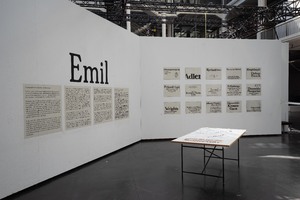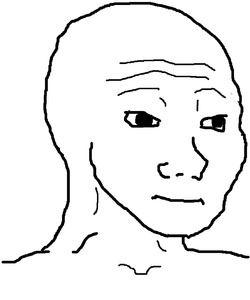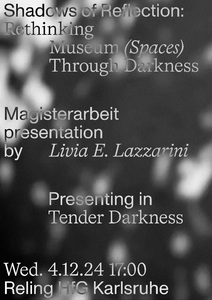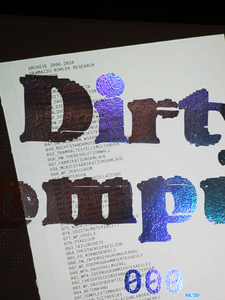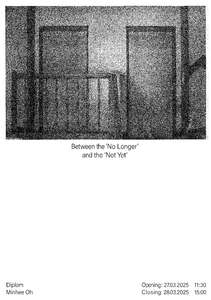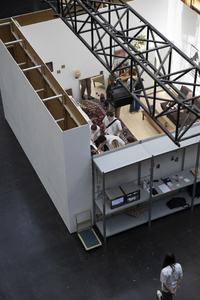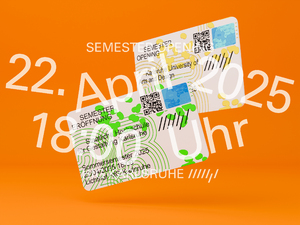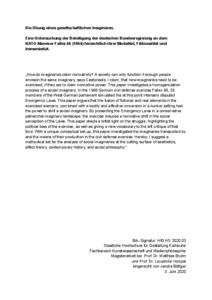Das ist ein Kinderspiel, not an Apple, 也就⼋年
Benachbarte Sets (122)Alle Zusammenhänge anzeigen
Diese Sets wurden den gleichen Sets hinzugefügt wie das ausgewählte Set.
122 Inhalte
- Seite 1 von 11
Wavebreaker
- Titel
- Wavebreaker
- Titel (en)
- Wavebreaker
- Untertitel
- Schallabsorbierende Fliesen
- Untertitel des Projekts/Werks (en)
- Sound absorbing tiles
- Autor/in
- Beschreibung (de)
- Wavebreaker ist ein modulares Fliesensystem, das entwickelt wurde, um Lärm in U-Bahn-Stationen wirksam zu reduzieren und die Aufenthaltsqualität spürbar zu verbessern. Die aus robuster Keramik gefertigten Fliesen werden im 3D-Druckverfahren hergestellt und lassen sich dadurch flexibel an verschiedene räumliche Situationen anpassen. Ihre Form orientiert sich an Schallwellen, wodurch sie nicht nur akustisch, sondern auch visuell zur Beruhigung des Raumes beitragen. Unterstützt wird dieser Effekt durch eine blaue Glasur, welche die ruhige Wirkung zusätzlich verstärkt.
Die schallabsorbierende Wirkung entsteht durch integrierte Helmholtz-Resonatoren und Schalldiffusoren, welche gezielt bestimmte Frequenzen aufnehmen, ohne dass poröse Materialien notwendig sind. Dies geschieht, indem der Schall in kleine Schlitze der Fliese eindringt und im Inneren in Hohlkammern resoniert und somit gedämpft wird. So wird der Umgebungslärm effektiv verringert, was zu einer entspannteren Atmosphäre im oft hektischen U-Bahn-Alltag führt. Dank ihres modularen und anpassungsfähigen Aufbaus eignen sich die Fliesen sowohl für Neubauten als auch für die Nachrüstung bestehender Stationen.
- Wavebreaker ist ein modulares Fliesensystem, das entwickelt wurde, um Lärm in U-Bahn-Stationen wirksam zu reduzieren und die Aufenthaltsqualität spürbar zu verbessern. Die aus robuster Keramik gefertigten Fliesen werden im 3D-Druckverfahren hergestellt und lassen sich dadurch flexibel an verschiedene räumliche Situationen anpassen. Ihre Form orientiert sich an Schallwellen, wodurch sie nicht nur akustisch, sondern auch visuell zur Beruhigung des Raumes beitragen. Unterstützt wird dieser Effekt durch eine blaue Glasur, welche die ruhige Wirkung zusätzlich verstärkt.
- Beschreibung (en)
- Wavebreaker is a modular tile system designed to effectively reduce noise in subway stations and noticeably improve the quality of stay. The tiles are made of durable ceramic and produced using 3D printing, which allows them to be flexibly adapted to different spatial conditions. Their shape is inspired by sound waves, helping to calm the environment not only acoustically but also visually. This effect is further supported by a blue glaze, which enhances the overall sense of calm.
The sound-absorbing effect is achieved through integrated Helmholtz resonators and sound diffusers, which target and absorb specific frequencies without the need for porous materials. This happens as sound enters small slits in the tile and resonates within internal cavities, where it is effectively dampened. As a result, ambient noise is significantly reduced, leading to a more relaxed atmosphere in the often hectic environment of subway stations. Thanks to their modular structure, the tiles are suitable for both new constructions and the retrofitting of existing stations.
- Wavebreaker is a modular tile system designed to effectively reduce noise in subway stations and noticeably improve the quality of stay. The tiles are made of durable ceramic and produced using 3D printing, which allows them to be flexibly adapted to different spatial conditions. Their shape is inspired by sound waves, helping to calm the environment not only acoustically but also visually. This effect is further supported by a blue glaze, which enhances the overall sense of calm.
- Kategorie
- Typ des Projekts/Werks
- Schlagworte
- Datierung
- 2024
- Dank an
- Material
- Technik/Verfahren/Formate
- Keramik 3D-Druck
- Abmessungen
- 15cm x 25cm x 5cm
- Ort: Institution
- Stadt
- Land
- Titel
- Wavebreaker
- Projektleiter/in
- Semester
- Studiengang
- Importiert am
- 26.06.2025
- Übergeordnete Sets
- 1
- Set enthält
- 0 16
Emil
- Titel
- Emil
- Titel (en)
- Emil
- Untertitel
- Typografie als Medium historischer Sichtbarkeit
- Untertitel des Projekts/Werks (en)
- A typographic revival reflecting historical erasure
- Autor/in
- Beschreibung (de)
- „Emil” ist ein Diplomprojekt, das die Rolle der Typografie im Umgang mit Erinnerung, Verdrängung und historischen Brüchen untersucht. Im Mittelpunkt stehen die Lebens- und Werkgeschichten jüdischer Gestalter:innen während des Nationalsozialismus, darunter Elizabeth Friedländer und Lucian Bernhard (geb. Emil Kahn).
Ein zentrales Element des Projekts ist das Revival der Bernhard Antiqua von Lucian Bernhard. Die Schrift wurde für die zeitgenössische Nutzung digital neu interpretiert und prägt die gesamte visuelle Ebene des Projekts – von der Plakatserie über die Ausstellungsgestaltung bis hin zur Vortragspräsentation. So wird Typografie zum Untersuchungsgegenstand und zum gestalterischen Werkzeug der Erinnerung.
Für Julian Jaffé, Nachfahre einer jüdischen Familie, die im Nationalsozialismus ins Exil gezwungen wurde, ist "Emil" nicht nur ein typografisches Projekt, sondern auch ein persönlicher Akt des Erinnerns.
- „Emil” ist ein Diplomprojekt, das die Rolle der Typografie im Umgang mit Erinnerung, Verdrängung und historischen Brüchen untersucht. Im Mittelpunkt stehen die Lebens- und Werkgeschichten jüdischer Gestalter:innen während des Nationalsozialismus, darunter Elizabeth Friedländer und Lucian Bernhard (geb. Emil Kahn).
- Beschreibung (en)
- Emil is a diploma project that examines the role of typography in dealing with memory, repression and historical ruptures. It focuses on the lives and works of Jewish designers during National Socialism, including Elizabeth Friedländer and Lucian Bernhard (born Emil Kahn).
A central element of the project is the revival of Bernhard Antiqua by Lucian Bernhard. The font has been digitally reinterpreted for contemporary use and shapes the entire visual level of the project – from the poster series to the exhibition design and lecture presentation. In this way, typography becomes both the subject of investigation and a creative tool of remembrance.
For Julian Jaffé, a descendant of a Jewish family forced into exile during the Nazi era, ‘Emil’ is not only a typographic project, but also a personal act of remembrance.
- Emil is a diploma project that examines the role of typography in dealing with memory, repression and historical ruptures. It focuses on the lives and works of Jewish designers during National Socialism, including Elizabeth Friedländer and Lucian Bernhard (born Emil Kahn).
- Kategorie
- Schlagworte
- Dank an
- Technik/Verfahren/Formate
- Typografie
- Titel
- Emil
- Projektleiter/in
- Semester
- Studiengang
- Typ der Abschlussarbeit
- Importiert am
- 26.06.2025
- Übergeordnete Sets
- 2
- Set enthält
- 0 13
By Users for Users
- Titel
- By Users for Users
- Untertitel
- Memes als digitale Folklore
- Untertitel des Projekts/Werks (en)
- Memes as Digital Folklore
- Autor/in
- Beschreibung (de)
- Die vorliegende Abschlussarbeit „By Users for Users. Memes als digitale Folklore“ untersucht die kulturellen, technologischen und politischen Dimensionen von Internet-Memes als eine der zentralen Bildpraktiken der Gegenwart. Memes werden dabei nicht nur als humoristische Phänomene, sondern als Ausdruck einer globalen, partizipativen Bildkultur verstanden, die häufig auch als eine Form digitaler Folklore-Kultur beschrieben wird. Die Arbeit untersucht die Bedeutungsebenen dieser Begrifflichkeit und analysiert neben den technischen und ästhetischen Rahmenbedingungen von Memes ihre identitätsstiftende Funktion innerhalb digital vernetzter Gemeinschaften sowie ihre Verstrickungen mit plattformkapitalistischen Infrastrukturen. Ein besonderer Fokus liegt darauf, wie einzelne Memes, Communitys und Plattformen durch reaktionäre Akteur:innen angeeignet und instrumentalisiert werden.
Als Fallbeispiel dient der Arbeit das sog. Wojak-Meme, eine dilettantisch erstellte Computergrafik eines melancholischen Gesichts. Wojak illustriert nicht nur die für Memes charakteristische Amateurästhetik, sondern auch, wie Memes als ‚visuelle Dialekte‘ bestimmter Communitys funktionieren und hierbei sowohl Gemeinschaft stiften als auch ausschließen können. Speziell das Wojak-Meme und seine Variationen werden durch die neurechte Alt-Right sowie durch die misogyne Incel-Community verwendet, um unter dem Deckmantel von Ironie und Humor Ideologien und Feindbilder zu erzeugen und zu verbreiten.
Genau wie der Philosoph Antonio Gramsci die Relevanz von Folklore für den frühen italienischen Faschismus beschrieb, trägt auch digitale Folklore maßgeblich zur Konstitution von Weltbildern bei und ist dabei oft wirkmächtiger als offizielle Normen und Gesetze. Was einst als eine ‚Demokratisierung der Bildproduktion‘ beschrieben wurde, ist längst zu einer Gefahr für die Demokratie geworden. Abschließend plädiert die Arbeit deshalb für eine kritische Folkloristik des Digitalen, die die Bildwelten der Partizipationskultur interdisziplinär zwischen Kunst- und Medienwissenschaften analysiert, um so deren Bildcharakter sowie die Dynamiken digitaler Infrastrukturen zu reflektieren.
- Die vorliegende Abschlussarbeit „By Users for Users. Memes als digitale Folklore“ untersucht die kulturellen, technologischen und politischen Dimensionen von Internet-Memes als eine der zentralen Bildpraktiken der Gegenwart. Memes werden dabei nicht nur als humoristische Phänomene, sondern als Ausdruck einer globalen, partizipativen Bildkultur verstanden, die häufig auch als eine Form digitaler Folklore-Kultur beschrieben wird. Die Arbeit untersucht die Bedeutungsebenen dieser Begrifflichkeit und analysiert neben den technischen und ästhetischen Rahmenbedingungen von Memes ihre identitätsstiftende Funktion innerhalb digital vernetzter Gemeinschaften sowie ihre Verstrickungen mit plattformkapitalistischen Infrastrukturen. Ein besonderer Fokus liegt darauf, wie einzelne Memes, Communitys und Plattformen durch reaktionäre Akteur:innen angeeignet und instrumentalisiert werden.
- Beschreibung (en)
- The M.A. thesis "By Users for Users. Memes as Digital Folklore" examines the cultural, technological and political dimensions of Internet memes as one of the central image practices of the present day. Memes are understood not only as a humorous phenomenon, but also as an expression of a global, participatory image culture, which is often described as a form of digital folklore culture. The text examines the layers of meaning of this terminology and, in addition to the technological and aesthetic conditions of memes, analyzes their identity-forming function within digitally networked communities as well as their entanglements with platform capitalist infrastructures. A particular focus is on how individual memes, communities and platforms are appropriated and instrumentalized by reactionary actors.
The so-called Wojak meme, an amateurishly created computer graphic of a melancholy face, serves as a case study. Wojak illustrates not only the amateur aesthetics characteristic of memes, but also the function of memes as ‘visual dialects’ of certain communities which simultaneously include and exclude individuals. In particular, the Wojak meme and its variations are used by the reactionary alt-right and the misogynistic incel community to create and disseminate ideologies and enemy images under the guise of irony and humor.
Just as philosopher Antonio Gramsci described the relevance of folklore for early Italian fascism, digital folklore also contributes significantly to the constitution of world views and, often proving more powerful than official laws and values. What was once described as a ‘democratization of image production’ has long since become a threat to democracy. In its conclusion, the thesis therefore advocates for a critical folkloristics of the digital that analyzes the visual worlds of participatory culture in an interdisciplinary way between art history and media studies in order to reflect on their visual character and the dynamics of digital infrastructures.
- The M.A. thesis "By Users for Users. Memes as Digital Folklore" examines the cultural, technological and political dimensions of Internet memes as one of the central image practices of the present day. Memes are understood not only as a humorous phenomenon, but also as an expression of a global, participatory image culture, which is often described as a form of digital folklore culture. The text examines the layers of meaning of this terminology and, in addition to the technological and aesthetic conditions of memes, analyzes their identity-forming function within digitally networked communities as well as their entanglements with platform capitalist infrastructures. A particular focus is on how individual memes, communities and platforms are appropriated and instrumentalized by reactionary actors.
- Kategorie
- Typ des Projekts/Werks
- Schlagworte
- Datierung
- 05.02.2025
- Dank an
- Sprache
- Abmessungen
- 144 Seiten (109 Textseiten)
- Titel
- By Users for Users
- Projektleiter/in
- Semester
- Studiengang
- Typ der Abschlussarbeit
- Importiert am
- 25.06.2025
- Übergeordnete Sets
- 2
- Set enthält
- 0 8
Aqua Logistik
- Titel
- Aqua Logistik
- Titel (en)
- Aqua logistics
- Autor/in
- Beschreibung (de)
- Aqua Logistik ist ein Konzept für ein alternatives Badezimmer. Im Mittelpunkt des Entwurfs steht eine Säule, die gleichzeitig als Wasserverteilungssystem dient. Durch das Einsetzen von Komponenten in die perforierte Säule können die Nutzer das Bad nach ihren Bedürfnissen gestalten. Durch die Vereinfachung und Minimierung des Wassermanagements fördert das System einen direkteren Umgang mit der wertvollen Ressource Wasser.
Der modulare Aufbau ermutigt zu unterschiedlichen Reinigungsroutinen und lädt dazu ein, die Gewohnheiten im Bad zu überdenken - und fördert so einen intelligenteren Umgang mit Wasser im privaten Bereich. Die Grundlage für dieses Konzept bildet eine selbst durchgeführte Untersuchung und Umfrage, die in einer Publikation mit dem Titel veröffentlicht wurde: „May I ask you some Questions about your Bathroom usage“.
- Aqua Logistik ist ein Konzept für ein alternatives Badezimmer. Im Mittelpunkt des Entwurfs steht eine Säule, die gleichzeitig als Wasserverteilungssystem dient. Durch das Einsetzen von Komponenten in die perforierte Säule können die Nutzer das Bad nach ihren Bedürfnissen gestalten. Durch die Vereinfachung und Minimierung des Wassermanagements fördert das System einen direkteren Umgang mit der wertvollen Ressource Wasser.
- Beschreibung (en)
- Aqua Logistics is a concept for an alternative bathroom. The design centers around a column that also serves as the water distribution system. By inserting components into the perforated column, users can customize the bathroom according to their needs. By simplifying and minimizing water management, the system fosters a more direct relationship with the valuable resource of water.
The modular setup encourages diverse cleaning routines and invites a rethinking of bathroom habits—ultimately promoting more intelligent water usage in private spaces. The base for this concepts relies on a self conducted research and survey, published in a book called: “May I ask you some Questions about your Bathroom usage“.
- Aqua Logistics is a concept for an alternative bathroom. The design centers around a column that also serves as the water distribution system. By inserting components into the perforated column, users can customize the bathroom according to their needs. By simplifying and minimizing water management, the system fosters a more direct relationship with the valuable resource of water.
- Kategorie
- Typ des Projekts/Werks
- Schlagworte
- Datierung
- 30.04.2025
- Mitwirkende
- Dank an
- Johannes Bauer
- Patricia Capalija
- Athina Chrisofakis
- Lukas Clark
- Lukas Dechau
- Fabian Düss
- Rustam Faradzev
- Hannes Holstein
- Chris Kabel
- Tobias Keilbach
- Alexander Knoppik
- Mikail Kolbasar
- Julian Kuf
- Stefan Legner
- Anouk Merceron
- Tim Miler
- Lea Möscheid
- Francesco Perale
- Jana Renger
- Sebastian Schäfer
- Sebastian Schilbach
- Susanne Schmitt
- Marlon Schüch
- Wieki Somers
- Yannik Thamm
- Thomas Traxler
- Leonard Wille
- Levi Zimmermann
- Material
- Abmessungen
- Breite: 150cm, Länge: 150cm, Höhe 220 cm
- Ort: Institution
- Ort
- Lichtbrücke
- Stadt
- Land
- Titel
- Aqua Logistik
- Projektleiter/in
- Semester
- Studiengang
- Typ der Abschlussarbeit
- Importiert am
- 16.06.2025
- Übergeordnete Sets
- 1
- Set enthält
- 0 16
Shadows of Reflection
- Titel
- Shadows of Reflection
- Untertitel
- Rethinking Museum (Spaces) Through Darkness
- Autor/in
- Beschreibung (de)
- In zeitgenössischen Museen können hell erleuchtete Räume - die so genannten „White Boxes“ - im Zusammenspiel mit Kunstwerken, die Szenen von Gewalt und Diskriminierung darstellen, befremdlich wirken. Auch wenn es wichtig ist, historische Ereignisse aufzuarbeiten und Minderheitengruppen sichtbar zu machen, kann der Kontrast zwischen der hellen Umgebung, dem behandelten Sachverhalt und der Realität selbst in diesen Kontexten zu einer Entfremdung führen.
Diese Magisterarbeit untersucht das Spannungsverhältnis zwischen hell erleuchteten Museumsräumen und der Darstellung schwieriger politischer Themen und schlägt dunkle Umgebungen als Gegennarrative vor. Keller, Bunker und Dunkelkammern können in diesem Sinne Erlösungsräume sein, die Platz für die Neudefinition von Machtstrukturen, für Freiheit und Emotionen lassen. Ein dunkler Raum ermöglicht somit transformative Erfahrungen, bei denen der Blick negiert und das Gefühl von Verletzlichkeit spürbar wird , was zu Überlegungen darüber einlädt, wie eine eingeschränkte Sichtbarkeit paradoxerweise unsere Fähigkeit, in einem umfassenderen, emotionaleren und bewussteren Sinne zu „sehen“, verstärken könnte. Dies wirft folgende Frage auf: Kann Dunkelheit emotionale Nähe fördern und neue Sichtweisen unterstützen?
- In zeitgenössischen Museen können hell erleuchtete Räume - die so genannten „White Boxes“ - im Zusammenspiel mit Kunstwerken, die Szenen von Gewalt und Diskriminierung darstellen, befremdlich wirken. Auch wenn es wichtig ist, historische Ereignisse aufzuarbeiten und Minderheitengruppen sichtbar zu machen, kann der Kontrast zwischen der hellen Umgebung, dem behandelten Sachverhalt und der Realität selbst in diesen Kontexten zu einer Entfremdung führen.
- Beschreibung (en)
- In contemporary museum spaces, the prevalence of brightly lit spaces – the so-called “white-boxes” – can be jarring when juxtaposed with artworks representing scenes of violence and discrimination. While it is essential to process historical events and give visibility to minority groups, in these contexts, the contrast between the bright environment, the subject matter and reality itself can create a disconnect.
This dissertation explores the tension between brightly lit museum spaces and their representation of challenging political subjects, proposing dark environments as a counter-narrative. Basements, bunkers and darkrooms, in this sense, can be redemption spaces that leave room for redefining power structures, for freedom and emotions. A dark space is thus a fundamental way of facilitating transformative experiences, where the gaze is negated and we all feel vulnerable, inviting considerations of how limited visibility might paradoxically enhance our ability to "see" in a broader, more emotionally and intentional engaged sense – raising the question: can darkness foster emotional proximity and encourage new ways of seeing?
- In contemporary museum spaces, the prevalence of brightly lit spaces – the so-called “white-boxes” – can be jarring when juxtaposed with artworks representing scenes of violence and discrimination. While it is essential to process historical events and give visibility to minority groups, in these contexts, the contrast between the bright environment, the subject matter and reality itself can create a disconnect.
- Kategorie
- Schlagworte
- Datierung
- 26.12.2024
- Sprache
- Titel
- Shadows of Reflection
- Projektleiter/in
- Semester
- Studiengang
- Typ der Abschlussarbeit
- Externes Archiv
- Importiert am
- 16.06.2025
- Übergeordnete Sets
- 0
- Set enthält
- 0 5
Dirty Computer
- Titel
- Dirty Computer
- Titel (en)
- Dirty Computer
- Autor/in
- Beschreibung (de)
- Eine Dirty Publication, entstanden im Rahmen des Seminars Dirty Computer an der HfG Karlsruhe, basierend auf der gemeinsamen Seminarwoche am Institut für Technologie in der Architektur (ITA) der ETH Zürich, zusammen mit Studierenden der Fotografieklasse von Armin Linke an der Akademie der Bildenden Künste München sowie der Gramazio Kohler Research Gruppe.
- Kategorie
- Mitwirkende
- Ort: Institution
- Ort
- Exkursion und Auftakt : 21–26.10. in Zürich
- Stadt
- Bemerkungen
- Ein Projekt in Kollaboration mit Gramazio Kohler Research, ETH Zürich sowie der Professur für Fotografie, Armin Linke, Akademie der Bildenden Künste München.
- Titel
- Dirty Computer
- Projektleiter/in
- Semester
- Studiengang
- Importiert am
- 12.06.2025
- Übergeordnete Sets
- 1
- Set enthält
- 0 10
Typography 1
- Titel
- Typography 1
- Titel (en)
- Typography 1
- Untertitel
- Characteristic Characters
- Untertitel des Projekts/Werks (en)
- Characteristic Characters
- Beschreibung (de)
- You’re the main characters! You’re such NPCs! Your character development was so good! Your character design is still a bit wonky! Sometimes you act out of character but you’re my favorite Characters! <3
Dieses Seminar ist eine praktische Einführung in die Typografie. Wir werden Buchstaben zeichnen und etwas über Schriftsysteme und das Alphabet lernen, Buchstaben zeichnen und ein Vokabular aufbauen, um über Buchstabenformen, die Unterschiede und Klassifizierungen von Schriften zu sprechen, Buchstaben zeichnen und die Lesbarkeit und den Charakter bewerten, Buchstaben zeichnen und einen Blick auf historische und zeitgenössische Kontexte wie Volkstypografie, Branding und Popkultur werfen.
- You’re the main characters! You’re such NPCs! Your character development was so good! Your character design is still a bit wonky! Sometimes you act out of character but you’re my favorite Characters! <3
- Beschreibung (en)
- You’re the main characters! You’re such NPCs! Your character development was so good! Your character design is still a bit wonky! Sometimes you act out of character but you’re my favorite Characters! <3
This seminar is a practical introduction to typography. We will draw letters and learn about writing systems and the alphabet, draw letters and build a vocabulary to speak about letterforms, the differences and classifications of typefaces, draw letters and evaluate readability and character, draw letters and look at historical and contemporary contexts such as vernacular typography, branding and pop culture.
- You’re the main characters! You’re such NPCs! Your character development was so good! Your character design is still a bit wonky! Sometimes you act out of character but you’re my favorite Characters! <3
- Typ des Projekts/Werks
- Schlagworte
- Datierung
- 23.10.2024 - 12.02.2025
- Mitwirkende
- Ort: Institution
- Ort
- 202
- Titel
- Typography 1
- Projektleiter/in
- Semester
- Studiengang
- Importiert am
- 12.06.2025
- Übergeordnete Sets
- 1
- Set enthält
- 0 30
Between the 'No Longer' and the 'Not Yet'
- Titel
- Between the 'No Longer' and the 'Not Yet'
- Autor/in
- Beschreibung (de)
- Der Titel dieser Ausstellung, "Between the 'No Longer' and the 'Not Yet'", stammt aus den Schriften von Victor Turner über Liminalität. Turner beschreibt Liminalität als einen Übergangszustand – einen Moment, in dem man eine frühere Rolle oder einen früheren Status verlassen hat aber noch nicht vollständig in eine neue Position eingetreten ist. Es ist ein Zustand der Ungewissheit und Transformation. Vertraute Strukturen lösen sich auf und lassen einen in einer undefinierten und instabilen Lage zurück.
Dieses Konzept spiegelt meine Erfahrung als Ausländerin in Deutschland wider. Ich habe Korea verlassen, befinde mich aber noch immer in einem Schwebezustand, ohne mich vollständig angekommen zu fühlen. Um diesen Zustand des Dazwischen auszudrücken, habe ich Flure als visuelle Metapher verwendet. Beim leisen Umherwandern durch diese Flure, beim Fotografieren aus der Distanz, bin ich mir selbst begegnet.
Aus dem fotografischen Projekt entwickelte sich die Videoarbeit "The Act of Cleaning" (2025), die gemeinsam mit den Fotografien gezeigt wird. Inspiriert von Mary Douglas' Ideen zu Reinigungsritualen – bei denen das Säubern Ordnung in das Chaos bringt –, habe ich das Putzen zu meinem eigenen Ritual gemacht. Douglas argumentiert, dass Gesellschaften Ordnung schaffen, indem sie Dinge in klare Kategorien einteilen. Doch Wesen oder Konzepte, die sich diesen Kategorien entziehen – wie Migrant*innen, Hybride oder diejenigen in Übergangszuständen –, werden oft als störend empfunden. In diesem Kontext wurde das Reinigen zu einem Weg, mit der Spannung des Dazwischenseins umzugehen.
Mit bloßen Händen wischte ich jede Stufe der Treppen ab, durch die ich mich bewegte. Die Reibung zwischen Lappen und Boden, das Geräusch des ausgewrungenen Wassers und das Echo meiner Schritte füllten den Flur. Der Boden wurde vollkommen durchnässt – die Grenze zwischen Reinigen und Verschmutzen verschwamm. Diese repetitive, beinahe meditative Handlung veränderte meine Beziehung zu diesen Räumen. Das Putzen wurde mehr als eine praktische Geste – es wurde zu einem Akt, meine Präsenz zu behaupten und sie zugleich zu hinterfragen.
Wie kann ich hier existieren?
- Der Titel dieser Ausstellung, "Between the 'No Longer' and the 'Not Yet'", stammt aus den Schriften von Victor Turner über Liminalität. Turner beschreibt Liminalität als einen Übergangszustand – einen Moment, in dem man eine frühere Rolle oder einen früheren Status verlassen hat aber noch nicht vollständig in eine neue Position eingetreten ist. Es ist ein Zustand der Ungewissheit und Transformation. Vertraute Strukturen lösen sich auf und lassen einen in einer undefinierten und instabilen Lage zurück.
- Beschreibung (en)
- The title of this exhibition, "Between the 'No Longer' and the 'Not Yet'", comes from Victor Turner's writings on liminality. Turner describes liminality as a transitional state—when one has left behind a previous role or status but has not yet fully entered a new one. It is a state of ambiguity and transformation. Familiar structures dissolve, leaving one in an undefined and unstable position.
This concept reflects my experience as a foreigner in Germany. I left Korea, yet I find myself lingering in a liminal state, not fully settled. To convey this in-between state, I used hallways as a visual metaphor. Wandering through hallways quietly, photographing them from a distance, I came face to face with myself.
This photographic project developed into the video work, "The Act of Cleaning" (2025), which is presented alongside the photographs. Inspired by Mary Douglas's ideas on purification rituals—where cleaning imposes order on chaos—I chose cleaning as my own ritual. Douglas argues that societies create order by classifying things into clear categories. Yet, beings or concepts that defy these categories—such as migrants, hybrids, or those in transitional states—are often seen as unsettling. In this context, cleaning became a way to navigate the tension of existing in ambiguity.
Using my bare hands, I wiped down each step of the staircases I walked through. The friction between the rag and the floor, the sound of squeezing water, and the echo of my footsteps filled the hallway. The floor became completely soaked, blurring the boundary between cleaning and staining. This repetitive, almost meditative act transformed my relationship with these spaces. Cleaning became more than a practical gesture—it was a way to assert my presence while simultaneously questioning it.
In what ways can I exist here?
- The title of this exhibition, "Between the 'No Longer' and the 'Not Yet'", comes from Victor Turner's writings on liminality. Turner describes liminality as a transitional state—when one has left behind a previous role or status but has not yet fully entered a new one. It is a state of ambiguity and transformation. Familiar structures dissolve, leaving one in an undefined and unstable position.
- Kategorie
- Typ des Projekts/Werks
- Schlagworte
- Datierung
- 29.05.2025
- Mitwirkende
- Dank an
- Ort: Institution
- Ort
- Lichthof
- Stadt
- Land
- Titel
- Between the 'No Longer' and the 'Not Yet'
- Projektleiter/in
- Semester
- Studiengang
- Typ der Abschlussarbeit
- Importiert am
- 29.05.2025
- Übergeordnete Sets
- 2
- Set enthält
- 0 9
existence.exe
- Titel
- existence.exe
- Titel (en)
- existence.exe
- Autor/in
- Beschreibung (de)
- Das Konzept der „Selbstoptimierung“ hat eine zunehmende gesellschaftliche Relevanz erreicht, dementsprechend haben zahlreiche Apps, die sich auf den Körper, die Emotionen und das Selbstmanagement konzentrieren, nach und nach mein Leben durchdrungen.
Ich scheine gleichzeitig in zwei Formen zu existieren: einerseits als organisches Wesen, das aus Wahrnehmung, Widersprüchen und zufälligen Erfahrungen besteht; andererseits als digitales Modell, das von verschiedenen Anwendungen konstruiert wurde.
Allmählich gewöhnte ich mich daran, mich selbst über Zahlen zu messen und zu analysieren – von der Kalorienaufnahme über Schlafzyklen bis hin zu feinen Schwankungen der Herzfrequenz – doch dabei verlor ich zunehmend das Vertrauen in die natürliche Wahrnehmung meines Körpers.
Diese Programme geben vor, „personalisierte Dienste“ zu sein, verwandeln uns letztlich aber in ein einheitliches Datenformat, das sich bequem kategorisieren, vergleichen und extrahieren lässt.
Je mehr Daten es über mich gibt, desto weniger scheine ich mich selbst zu spüren.
- Das Konzept der „Selbstoptimierung“ hat eine zunehmende gesellschaftliche Relevanz erreicht, dementsprechend haben zahlreiche Apps, die sich auf den Körper, die Emotionen und das Selbstmanagement konzentrieren, nach und nach mein Leben durchdrungen.
- Beschreibung (en)
- As “self-optimization” has become a widely accepted life concept, a large number of apps focusing on the body, emotions, and self-management have gradually infiltrated my life.
I seem to exist in two forms at the same time: one, an organic being composed of perception, contradictions, and incidental experiences; the other, a digital model constructed by various applications.
I gradually got used to measuring and examining myself through numbers—from calorie intake to sleep cycles and subtle fluctuations in heart rate—but in doing so, I slowly lost trust in my body’s natural perception.
These programs present themselves as “personalized services,” yet ultimately convert us into a single data format, convenient for categorization, comparison, and extraction.
The more data there is about me, the less I seem to feel myself.
- As “self-optimization” has become a widely accepted life concept, a large number of apps focusing on the body, emotions, and self-management have gradually infiltrated my life.
- Kategorie
- Typ des Projekts/Werks
- Schlagworte
- Datierung
- 14.05.2025
- Mitwirkende
- Dank an
- Dauer
- 2 Tage
- Ort: Institution
- Ort
- Lichthof 4
- Stadt
- Land
- Titel
- existence.exe
- Projektleiter/in
- Semester
- Studiengang
- Typ der Abschlussarbeit
- Importiert am
- 19.05.2025
- Übergeordnete Sets
- 2
- Set enthält
- 0 26
Semestereröffnung Sommer 2025
- Titel
- Semestereröffnung Sommer 2025
- Titel (en)
- Semester Opening Summer 2025
- Autor/in
- Beschreibung (de)
- Eröffnung des Sommersemesters am Dienstag, 22. April 2025 um 18.00 Uhr an der HfG Karlsruhe. Eintritt frei.
Die Staatliche Hochschule für Gestaltung (HfG) Karlsruhe kann das Sommersemester 2025 mit einer guten Nachricht eröffnen: Neben einer Reihe neuer Mitarbeiterinnen und Mitarbeiter sind wieder neue Berufungen zu feiern.
Wie gewohnt, wird der Eröffnungsabend auch für die Überreichung von Diplomzeugnissen genutzt. Neben einigen Grußworten sind außerdem performative Beiträge zu erleben. Im Anschluss an den offiziellen Teil des Abends dürfen sich Studierende und Gäste auf einen gemeinsamen musikalischen Ausklang im Lichthof freuen.
Weitere Details folgen.
- Eröffnung des Sommersemesters am Dienstag, 22. April 2025 um 18.00 Uhr an der HfG Karlsruhe. Eintritt frei.
- Beschreibung (en)
- Opening of the summer semester on Tuesday, April 22, 2025 at 6pm at HfG Karlsruhe. Free Entry
The Karlsruhe University of Arts and Design (HfG) can open the 2025 summer semester with good news: In addition to a number of new employees, there are once again new appointments to celebrate.
As usual, the opening evening will also be used for the presentation of diploma certificates. In addition to a few welcoming speeches, there will also be performative contributions. Following the official part of the evening, students and guests can look forward to a musical finale together in the atrium.
Further details will follow.
- Opening of the summer semester on Tuesday, April 22, 2025 at 6pm at HfG Karlsruhe. Free Entry
- Datierung
- 22.04.2025
- Ort: Institution
- Titel
- Semestereröffnung Sommer 2025
- Importiert am
- 15.04.2025
- Übergeordnete Sets
- 1
- Set enthält
- 0 1
Die Übung eines gesellschaftlichen Imaginären
- Titel
- Die Übung eines gesellschaftlichen Imaginären
- Untertitel
- Eine Untersuchung der Beteiligung der deutschen Bundesregierung an dem NATO-Manöver Fallex 66 (1966) hinsichtlich ihrer Modalität, Fiktionalität und Immersivität.
- Autor/in
- Beschreibung (de)
- „How do imaginaries claim normativity? A society can only function if enough people envision the same imaginary, says Castoriadis. I claim, that new imaginaries need to be exercised, if they are to claim normative power. This paper investigates a homogenization process of a social imaginary: In the 1966 German civil defense exercise Fallex 66, 33 members of the West German parliament simulated the at this point intensely disputed Emergency Laws. This paper argues that the fusion of fictional and real elements in the exercised scenario, combined with a bodily and affective immersion in a bunker setting had the power to shift a social imaginary. By presenting the Emergency Laws in a conservative patriarchal imaginary landscape, the exercise induces a normative shift in the social perception of the Laws. This paper sheds a leftist light on the struggle, highlighting the political bias of the exercise, as well as giving a new vocabulary to the left critique of that time. With a unique conceptual set-up, this paper investigates the imaginaries transported by and the means of their production in the civil defense exercise. Hereby, I suggest a methodical set for the analysis of social imaginaries at the cutting surface of aesthetics, affect theory, contemporary history, and social philosophy.”
- Beschreibung (en)
- „How do imaginaries claim normativity? A society can only function if enough people envision the same imaginary, says Castoriadis. I claim, that new imaginaries need to be exercised, if they are to claim normative power. This paper investigates a homogenization process of a social imaginary: In the 1966 German civil defense exercise Fallex 66, 33 members of the West German parliament simulated the at this point intensely disputed Emergency Laws. This paper argues that the fusion of fictional and real elements in the exercised scenario, combined with a bodily and affective immersion in a bunker setting had the power to shift a social imaginary. By presenting the Emergency Laws in a conservative patriarchal imaginary landscape, the exercise induces a normative shift in the social perception of the Laws. This paper sheds a leftist light on the struggle, highlighting the political bias of the exercise, as well as giving a new vocabulary to the left critique of that time. With a unique conceptual set-up, this paper investigates the imaginaries transported by and the means of their production in the civil defense exercise. Hereby, I suggest a methodical set for the analysis of social imaginaries at the cutting surface of aesthetics, affect theory, contemporary history, and social philosophy.”
- Kategorie
- Schlagworte
- Datierung
- 3. Juni 2020
- Sprache
- Ort: Institution
- Titel
- Die Übung eines gesellschaftlichen Imaginären
- Projektleiter/in
- Semester
- Studiengang
- Typ der Abschlussarbeit
- Archiv-Signatur
- HfG HS 2020 03
- Externes Archiv
- Importiert am
- 30.03.2025
- Übergeordnete Sets
- 2
- Set enthält
- 0 4

